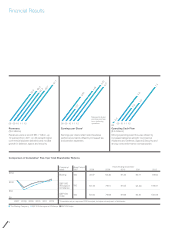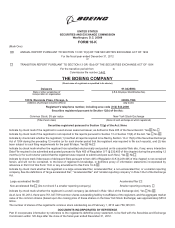Boeing 2012 Annual Report Download - page 20
Download and view the complete annual report
Please find page 20 of the 2012 Boeing annual report below. You can navigate through the pages in the report by either clicking on the pages listed below, or by using the keyword search tool below to find specific information within the annual report.8
increases, we may be unable to meet delivery schedules and the financial performance of one or more of
our programs may suffer.
Operational challenges impacting the production system for one or more of our commercial aircraft
programs could result in production delays and/or failure to meet customer demand for new aircraft, either
of which would negatively impact our revenues and operating margins. Our commercial aircraft production
system is extremely complex. Operational issues, including delays or defects in supplier components,
failure to meet internal performance plans, or delays or failures to achieve required regulatory certifications,
could result in significant out-of-sequence work and increased production costs, as well as delayed
deliveries to customers, impacts to aircraft performance and/or increased warranty or fleet support costs.
Further, if we cannot efficiently and cost-effectively incorporate design changes into already-completed
787 and 747-8 production aircraft, we may face further profitability pressures on these programs.
If our commercial airplanes fail to satisfy performance and reliability requirements, we could face additional
costs and/or lower revenues. Developing and manufacturing commercial aircraft that meet or exceed our
performance and reliability standards, as well as those of customers and regulatory agencies, can be
costly and technologically challenging. These challenges are particularly significant with newer aircraft
programs. Any failure of any Boeing aircraft to satisfy performance or reliability requirements could result
in disruption to our operations, higher costs and/or lower revenues.
Changes in levels of U.S. government defense spending or overall acquisition priorities could
negatively impact our financial position and results of operations.
We derive a substantial portion of our revenue from the U.S. government, primarily from defense related
programs with the U.S. DoD. Levels of U.S. defense spending in future periods are very difficult to predict
and subject to significant risks. In addition, significant budgetary constraints may result in further reductions
to projected spending levels. In particular, U.S. government expenditures are subject to the potential for
automatic reductions, generally referred to as “sequestration.” Sequestration may occur during 2013,
resulting in significant additional reductions to spending by the U.S. DoD on both existing and new contracts
as well as disruption of ongoing programs. We expect that sequestration would have similar impacts on
other U.S government customers, such as NASA and various intelligence agencies. Even if sequestration
does not occur, we expect that budgetary constraints and ongoing concerns regarding the U.S. national
debt will continue to place downward pressure on U.S. DoD spending levels. Due to these and other
factors, overall U.S. government defense spending could decline, which could result in significant
reductions to revenue, cash flow, profit and backlog primarily in our BDS business.
In addition, as a result of the significant ongoing uncertainty with respect to both U.S. defense spending
levels and the nature of the threat environment, we expect the U.S. DoD to continue to emphasize cost-
cutting and other efficiency initiatives in its procurement processes. If we can no longer adjust successfully
to these changing acquisition priorities and/or fail to meet affordability targets set by the U.S. DoD customer,
our revenues and market share would be further impacted.
We conduct a significant portion of our business pursuant to U.S. government contracts, which
are subject to unique risks.
In 2012, 33% of our revenues were earned pursuant to U.S. government contracts, which include foreign
military sales through the U.S. government. Business conducted pursuant to such contracts is subject to
extensive procurement regulations and other unique risks.
Our sales to the U.S. government are subject to extensive procurement regulations, and changes to those
regulations could increase our costs. New procurement regulations, or changes to existing requirements,
could increase our compliance costs or otherwise have a material impact on the operating margins of our
BDS business. For example, in 2012 the U.S. DoD issued a final rule implementing regulations that
























